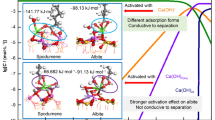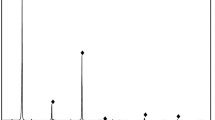Abstract
The separation of azodicarbonamide (AC) from the surface of diatomite by froth flotation is investigated in this research. Pure samples of diatomite, AC and 1:1 mixtures of the two were floated in a lab-scale flotation cell with collector dosage, frother type and dosage, and pH varied to determine the optimum experimental conditions. The diatomite sample and products from flotation tests were characterized using scanning electron microscopy (SEM) equipped with energy dispersive X-ray spectroscopy (EDX). The results of the flotation tests indicate that there is less AC on the surface of diatomite after flotation compared to the feed, while the AC present in diatomite pores remains unchanged. Additionally, Fourier transform infrared spectroscopy (FT-IR) was employed to study the mechanism of interaction between reagents and minerals.
摘要
硅藻土是一种具有独特微孔结构的硅质沉积岩, 可用作吸附或填充材料。 偶氮二甲酰胺是工业上广泛应用的一种发泡剂, 将偶氮二甲酰胺填充到硅藻土孔隙中能改善硅藻土性能, 使其同时具有硅藻土和偶氮二甲酰胺特性, 覆盖在硅 藻土表面的偶氮二甲酰胺会影响改性材料的性能。 本文通过微泡浮选对硅藻土表面分离偶氮二甲酰胺进行了研究, 考察了捕收剂用量、 起泡剂种类和用量、 pH 值对分离效果的影响, 结果表明: 当起泡剂 MC-1 用量为 60 mg/L, 捕收剂煤油用量为 80 mg/L, pH 为 5 时, 效果最好, 偶氮二甲酰胺与硅藻土的上浮率之差达到 89.4%, 偶氮二甲酰胺的回收率达到 72.5%。 通过扫描电镜和能谱对浮选产品进行表征, 结果表明:与原矿相比, 浮选后硅藻土表面偶氮二甲酰胺大幅度减少, 硅藻土孔隙中偶氮二甲酰胺基本不变。 通过红外光谱研究了药剂与矿物之间的作用机理, 表明硅藻土与煤油之间不存在化学吸附, 浮选体系中煤油与 MC-1 形成一种乳状液, 吸附于硅藻土表面形成保护层, 防止药剂和矿浆与硅藻土孔隙内的 AC 相互作用。
Similar content being viewed by others
References
YE Xin-xin, KANG Sheng-hong, WANG Hui-min, LI Hong-ying, ZHANG Yun-xia, WANG Guo-zhong, ZHAO Hui-jun. Modified natural diatomite and its enhanced immobilization of lead, copper and cadmium in simulated contaminated soils [J]. Journal of Hazardous Materials, 2015, 289: 210–218.
DOBOR J, PERÉNYI K, VARGA I, VARGA M. A new carbon–diatomite earth composite adsorbent for removal of heavy metals from aqueous solutions and a novel application idea [J]. Microporous and Mesoporous Materials, 2015, 217: 63–70.
FU Xiao-wei, LIU Zhi-meng, XIAO Yao, WANG Ji-liang, LEI Jing-xin. Preparation and properties of lauric acid/diatomite composites as novel form-stable phase change materials for thermal energy storage [J]. Energy and Buildings, 2015, 104: 244–249.
HA J, LEE J, SONG I, LEE S. The effects of diatomite addition on the pore characteristics of a pyrophyllite support layer [J]. Ceramics International, 2015, 41: 9542–9548.
INCHAURRONDO N, FONT J, RAMOS C P, et al. Natural diatomites: Efficient green catalyst for Fenton-like oxidation of Orange II [J]. Applied Catalysis B: Environmental, 2016, 181: 481–494.
WANG Bin, ZHANG Guang-xin, SUN Zhi-ming, ZHENG Shui-lin. Synthesis of natural porous minerals supported TiO2 nanoparticles and their photocatalytic performance towards Rhodamine B degradation [J]. Powder Technology, 2014, 262: 1–8.
CHEMI FISHBEIN L. Chemicals used in the rubber industry [M]// Anthropogenic Compounds. Berlin Heidelberg: Springer, 1990: 33–43.
LANDROCK A H. Additives, fillers and reinforcements [M]. Handbook of plastic foams. Park Ridge, NJ: William Andrew Publishing, 1995: 278–315.
LI Ji-xin, ZHANG Guo, LIU Zhuo-shi, WANG Xin-lei, LIU Xiu-qi. Resistivity-temperature behavior of CB-filled HDPE foaming composites [J]. Chemical Research in Chinese Universities, 2008, 24(2): 215–219.
MCCURDY R H, HUTCHINSON A R, WINFIELD P H. The mechanical performance of adhesive joints containing active disbonding agents [J]. International Journal of Adhesion and Adhesives, 2013, 46: 100–113.
QIN Yue, LENG Guang-hui, YU Xiang, CAO Hui, QIAO Geng, DAI Yun-feng, ZHANG Ye-long, DING Yu-long. Sodium sulfate–diatomite composite materials for high temperature thermal energy storage [J]. Powder Technology, 2015, 282: 37–42.
AN O, G REN R, ZGÜR C. Purification of diatomite powder by acid leaching for use in fabrication of porous ceramics [J]. International Journal of Mineral Processing, 2009, 93(1): 6–10.
JUNG K, JANG D, AHN K. A novel approach for improvement of purity and porosity in diatomite (diatomaceous earth) by applying an electric field [J]. International Journal of Mineral Processing, 2014, 131: 7–11.
SUN Zhi-ming, YANG Xiao-ping, ZHANG Guang-xin, ZHENG Shui-lin, FROST R L. A novel method for purification of low grade diatomite powders in centrifugalfields [J]. International Journal of Mineral Processing, 2013, 125: 18–26.
LUO Guo-qing, GAO Hui-min, REN Zi-jie, LIU Xi. Experimental research on purification of a low-grade diatomite of Jilin [J]. Non-Metallic Mines, 2014, 37(1): 63–65. (in Chinese)
ZHENG Shui-lin, SUN Zhi-ming, HU Zhi-bo, ZHANG Guang-xin. The processing and utilization of China diatomite resource and its development trend [J]. Earth Science Frontiers, 2014(05): 274–280. (in Chinese)
DANIL de NAMOR A F, EL GAMOUZ A, FRANGIE S, MARTINEZ V, VALIENTE L, WEBB O A. Turning the volume down on heavy metals using tuned diatomite. A review of diatomite and modified diatomite for the extraction of heavy metals from water [J]. Journal of Hazardous Materials, 2012, 241–242: 14–31.
URAGAMI T. Selective membranes for purification and separation of organic liquid mixtures [M]// Comprehensive Membrane Science and Engineering. Oxford: Elsevier, 2010: 273–324.
DICK J S, RADER C P. Antioxidants, antiozonants, tackifiers, flame retardants, and blowing agents [M]// Raw Materials Supply Chain for Rubber Products. Munich: Carl Hanser verlag GmbH & Co. KG, 2014: 329–373.
KHRAISHEH M A M, AL-GHOUTI M A, ALLEN S J, AHMAD M N. Effect of OH and silanol groups in the removal of dyes from aqueous solution using diatomite [J]. Water Research, 2005, 39(5): 922–932.
SHENG Guo-dong, WANG Suo-wei, HU Jun, LU Yi, LI Jia-xing, DONG Yun-hui, WANG Xiang-ke. Adsorption of Pb(II) on diatomite as affected via aqueous solution chemistry and temperature [J]. Colloids and Surfaces A: Physicochemical and Engineering Aspects, 2009, 339(1–3): 159–166.
AL-GHOUTI M A, AL-DEGS Y S. New adsorbents based on microemulsion modified diatomite and activated carbon for removing organic and inorganic pollutants from waste Lubricants [J]. Chemical Engineering Journal, 2011, 173(1): 115–128.
LIU Hong-jun, ZHANG Wei, SUN Chun-bao. Influence of bubble diameter and solids concentration on bubble stability: Development of a novel analytical approach [J]. Journal of Central South University, 2014, 21: 3588–3595.
ZHANG Wei, FINCH J A. Effect of solids on pulp and froth properties in flotation [J]. Journal of Central South University, 2014, 21: 1461–1469.
KANG Wen-ze, WANG Hui, KONG Xiao-hong, LÜ Yu-ting, HU Jun. Study of flotation performance of kerosene after ultrasonic emulsified [J]. Journal of China Coal Society, 2008, 33(1): 89–93. (in Chinese)
LÜ Yu-ting, WANG Jin-cao, LÜ Yi-bo. Emulsification and floatation of kerosene catch agent [J]. Coal Science and Technology, 2004, 32(8): 57–59. (in Chinese)
SUYANTARA G P W, HIRAJIMA T, ELMAHDY A M, MIKI H, SASAKI K. Effect of kerosene emulsion in MgCl2 solution on the kinetics of bubble interactions with molybdenite and chalcopyrite [J]. Colloids and Surfaces A: Physicochemical and Engineering Aspects, 2016, 501: 98–11.
Author information
Authors and Affiliations
Corresponding author
Additional information
Foundation item: Project((2011)4012) supported by the High-Level of Innovative Talents of Guizhou Province, China
Rights and permissions
About this article
Cite this article
Zhang, Q., Xie, J., Chen, Jh. et al. Separation of azodicarbonamide from surface of diatomite by froth flotation. J. Cent. South Univ. 25, 29–37 (2018). https://doi.org/10.1007/s11771-018-3714-y
Received:
Accepted:
Published:
Issue Date:
DOI: https://doi.org/10.1007/s11771-018-3714-y




